How to Navigate at Night
Navigation is a lot easier when you can see what is going on around you. At night, the familiar scene of land, buoys and other navigation marks disappear to be replaced by fixed and flashing lights. Ships and boats are seen as a set of lights in various colors rather than their familiar outline.
Instead of your natural visual interpretation of things that you can see in daylight, everything is in code at night and you need to change your approach. There is no quick fix and you have to decipher the meaning of the lights before you can understand what you are seeing and develop a course of action. To the experienced seaman, this all comes naturally and he/she can make the transition without a thought. For the less experienced, and indeed for the first-timer to night navigation, the change becomes a challenge.
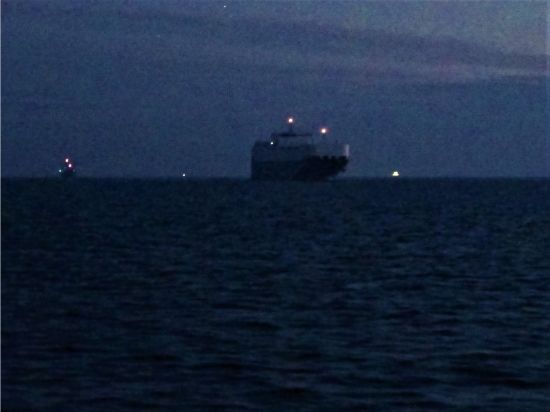
Learning the Code
Translating the code of the lights into meaningful information adds to the navigator's workload considerably -- at a time when he/she may already be under pressure from having operated the boat in the dark anyway. The familiar pilothouse of the daylight hours becomes a place where you may have to search for switches and controls. The contrast from the world inside the dark world outside can be a cliff edge of experience. Night navigation can certainly be challenging but there are ways to simplify things if you get organized.
Autopilot
The first step in simplification is to use the autopilot for steering. Not only does this relieve you of the job of concentrating on the compass and steering the boat but it stabilizes the view of the outside world. One of the biggest problems that you can face at night is when the heading of the boat is swinging about as you may steer a somewhat erratic course. That makes it much harder to identify flashing lights and to find them again when you need to use them as a reference.
With autopilot steering, these lights you are using as references remain in the same part of the horizon. So, a flashing light is easier to find and there will be less confusion with the lights of boats and ships.
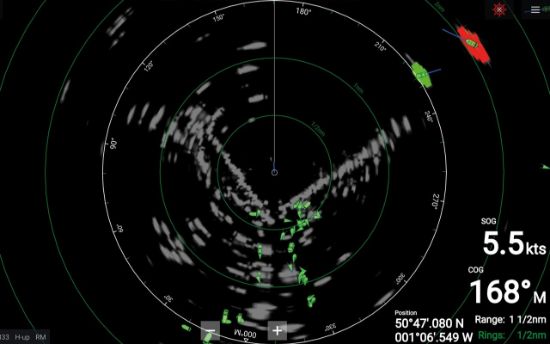
With autopilot steering the boat, the radar display will be stabilized so you will have a much better and more useable picture. Buoys, other boats and ships will stay in the same place on the screen in the short term and it will be much easier to relate them to the lights that you see outside. It also means that getting a relative bearing of targets will be easier for collision avoidance. There are so many plus points in using the autopilot that it becomes a must at night, particularly if you are the only person on watch.
- Using the autopilot can reduce the workload and keep a steadier course.
- Always check the electronic positions with visual checks when possible.
- Have the characteristics of navigation lights readily available before starting.
- Remember, it can be difficult to judge distances at night.
- Electronics can help and lot but do not rely on them totally, particularly radar.
- Spotting the lights of other yachts against the shore lights can be challenging.
The basic method of navigating at night is very much the same as navigation in daylight. You do your passage planning and work out the course that you want to follow either on the paper chart or the electronic one. You mark the waypoints where the course will be altered and check the route in detail to ensure that you are not passing close or even over the top of any dangers.
Plans for Nighttime
Now is the time to look at adapting your navigation plan to make night navigation easier and safer. A first step here is to look along the route to see where there are navigation lights that will provide you with that vital visual check to show that the electronic systems are giving you reliable information. Even in these days when the number of lights is being cut back, there are still enough lights left out there so that you should always have one in sight when navigating along a coastline. The challenge in your navigation planning is to make the best use of these lights to help check out the electronics.
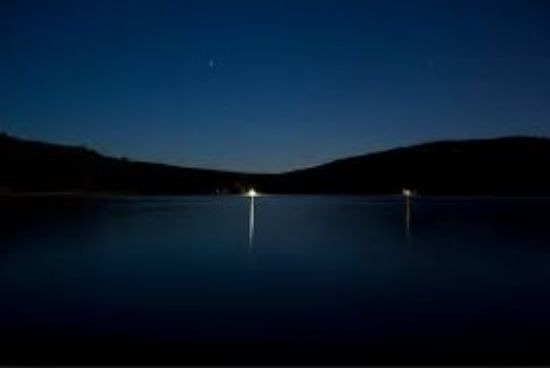
Trying to identify lights at night can be a real challenge. They flash with different characteristics so that each can be identified but trying to peer at the chart and see which lights are relevant can be challenging when there are several flashing lights in view, as you might find when navigating along a buoyed channel. It can be hard to read the small print on the chart when the boat is bouncing around in waves. So, the solution with a paper chart is to ring the buoy icon with a pencil and pencil in the light characteristics in larger figures so that you can see things at a glance.
You might also want to adjust the courses you set to make life easier at night. Rather than take the direct route between waypoints, you might find it beneficial to take a course that passes close to a buoy or another mark with a light. This will give you a positive position check as you pass. If you are steering manually, having a light ahead or nearly ahead to steer on is much easier than trying to steer a compass course.

Do not steer directly towards a buoy light because it is much harder to judge distances at night, particularly from a flashing buoy light. You can suddenly find yourself much closer to the buoy than you intended. In particular, watch out for the tide setting you down towards the buoy. As you approach a buoy at night, make sure that the bearing of the buoy is opening up as you get closer to indicate that you will pass well clear of it when it is abeam. I have had several close encounters with buoys at night because I ignored this advice.
Visual Lookout
For the visual lookout at night, make a slow scan of the horizon rather than a quick glance. Flashing lights may only show up at intervals and the often small, faint lights that might be a small boat can be hard to pick out with just a glance. So, a good steady lookout is vital at night.
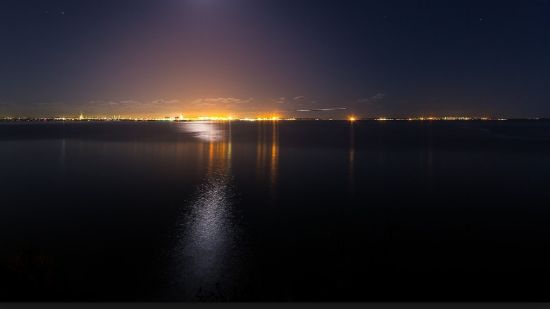
If you are the only person on watch at night, you will have a full-time job. You have to be on the lookout, scanning the horizon for lights. You have to monitor the navigation and you have to steer the boat. The temptation will always be to focus on electronic screens because these are the most interesting things in view. There is no doubt that they will give you a lot of the information you need for navigating the boat safely but there is no guarantee that they will show up everything that is out there. If there are moderate or rough seas, a small boat target can easily be lost amongst the sea clutter on the radar and you might not pick it up at all.
Collision Avoidance
For collision avoidance at night, you need to know the Colregs (International Regulations for Preventing Collisions at Sea) and understand what all the different lights mean. You will not get the clear, precise heading of another vessel that you can in daylight from the lights unless it is coming directly towards you. So, watching the bearing of the other vessel and how it changes is vital. Even more vital is when the bearing does not change. Then you have to do something about the situation before a collision occurs.
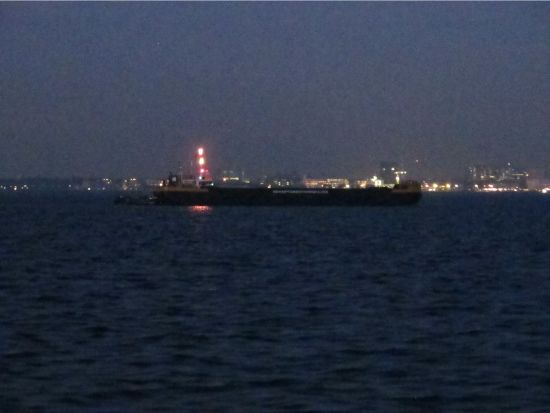
The requirements for navigation lights at night are far from perfect. A sailboat at night will only show its red and green lights, which do not show up anything like a white light. Then a single white light could mean many things, it could be a stern light, a small boat, or possibly an anchor light. You can be quite close before you see a weak light so constant vigilance is particularly vital in crowded waters and when there are a lot of background lights, such as when you are entering the harbor. Also, make sure that your own navigation lights are in good order so other craft can see you.
The importance of keeping a lookout at night has already been emphasized. Remember that the mullions on the pilothouse windows could hide the lights of a ship or boat out on the horizon. Dim the displays and dials in the cockpit and change their color if possible so that they do not dazzle. Bits of sticky tape can help cut down on indicator lights that cannot be dimmed.
One thing that can be very important when you are choosing electronics equipment is to make sure that it is not only the screen that lights up at night but also the control buttons. If you have to get a flashlight out every time you want to alter a setting, it will not only take your mind off the navigation itself but it will also destroy your night vision. Having the autopilot standby switch illuminated, so that you can find it quickly in the dark, is also vital.
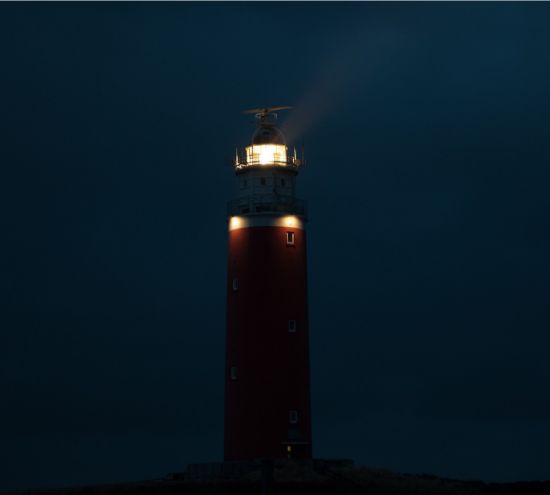
Organization
You need planning before you start, you need an organized helm and you need concentration when you are navigating at night. However, the most challenging part of the job at night is entering the harbor. A big lighthouse at a harbor entrance should show up well against the shore lights and give you a guide to find the location of the entrance channel. However, if you have to pick out a buoy light against the shore lights it can be a real struggle to find it. Once you have found the first fairway buoy then it will be easier to locate the others against the shore lights because you will know approximately where to look but it is never easy.
It can be very difficult to see the weak lights of small craft against the shore lights as well. The radar can be a great help here but as we have already said, radar cannot guarantee to pick up every small vessel, so the visual lookout is vital. You are better off navigating from the flybridge if that is an option. Here you will have a much clearer view and less contaminated view when entering the harbor and it could be good practice to have a lookout on the bow.

Proper electronics
The electronic chart can be very valuable when entering the harbor at night. The GPS should be accurate enough to position you in the entrance channel and to show a plain view of an unfamiliar harbor. Don't rely on it as the complete solution but it can help considerably to sort out the various features of the harbor before you can identify them visually.
Navigating at night can stretch your navigation skills. In addition to careful planning, you need a higher level of concentration than in the daytime. In return, you will get a great sense of achievement when you make harbor after a successful night passage.
